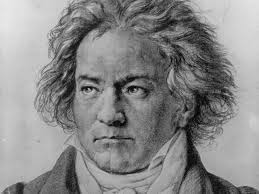A student asks about approaches to this late and remarkably expressive sonata, one of a trilogy of final works in the form that bring to a close the composer's thoughts on the subject. The opening is string quartet-like, featuring first violin, with support in the cello, though each voice has its own inflection. Take care to play legato, with pedal assistance, without clinging to the notes like an organist. The tune that emerges is in the nature of an arioso, almost operatic, requiring a simple though well-voiced accompaniment, which can be nicely controlled by riding the key. That is, stay in contact with the surface of the key, returning only just past the point of sound before depressing it again. Divide the arpeggios between the hands if you like (much easier). It's possible to play this passage beautifully either way. Take which ever feels easier. It's not cheating to redivide the hands. The dots (wedges) over the first note of each group of four are not staccatos, but rather indications to show them, like accents.
 In the second movement, Beethoven turns from the sublime to the ridiculous. So, don't fuss over elegance here, or even force a super fast tempo. Legend has it that the tune is based on a folk song: "I'm a bum, You're a bum, We're all bums!"
In the second movement, Beethoven turns from the sublime to the ridiculous. So, don't fuss over elegance here, or even force a super fast tempo. Legend has it that the tune is based on a folk song: "I'm a bum, You're a bum, We're all bums!"
The fugues, of course, are to sound like lines moving horizontally. As pianists, though, we have to consider for technical reasons the verticalness. That is, what happens in the hands at points where the hands come together. Once you figure this out, mastering the counterpoint is much easier.
Do read the score carefully. Beethoven was particular not only about notation but other instructions as well, even pedaling in the transition leading up to the first slow section. The word ermattet in the Klagender Lied, for example, means spent or exhausted. And what is that repeated note all about? Some authorities think of it as a bebung, a sort of vibrato left over from clavichord technique.
Most of all, enjoy this remarkable piece.

No comments:
Post a Comment